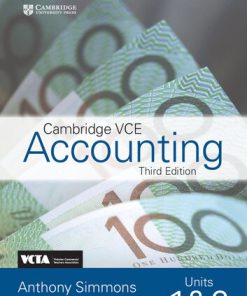Cambridge VCE Accounting Units 3 and 4 4th Edition by Anthony Simmons, Richard Hardy ISBN 9781108469890 1108469892
$50.00 Original price was: $50.00.$25.00Current price is: $25.00.
Cambridge VCE Accounting Units 3 and 4 4th Edition by Anthony Simmons, Richard Hardy – Ebook PDF Instant Download/Delivery: 9781108469890 ,1108469892
Full download Cambridge VCE Accounting Units 3 and 4 4th Edition after payment

Product details:
ISBN 10: 1108469892
ISBN 13: 9781108469890
Author: Anthony Simmons, Richard Hardy
a comprehensive textbook designed specifically for the Victorian Certificate of Education (VCE) Accounting course (Units 3 & 4). The text provides a clear and structured progression from foundational accounting principles—such as the accounting equation, the general ledger and inventory management—through to more advanced concepts like budgeting, cash-flow statements and ethical decision-making. It features coloured diagrams, margin definitions, study tips and review questions at the end of each section, all aligned to the current VCE study design and aimed at building skills systematically and preparing students for examinations.
Cambridge VCE Accounting Units 3 and 4 4th Edition Table of contents:
Chapter 1
The role of Accounting
1.1 The purpose of Accounting
1.2 Users of financial information
1.3 The Accounting process
1.4 Accounting assumptions
1.5 Qualitative characteristics
1.6 Elements of Accounting reports
Chapter 2
The Accounting equation
2.1 Assets, liabilities and owner’s equity
2.2 The Balance Sheet
2.3 Classification in the Balance Sheet
2.4 Double-entry Accounting
Chapter 3
The General Ledger
3.1 Ledger accounts and the General Ledger
3.2 Double-entry recording in ledger accounts
3.3 Recording revenues and expenses
3.4 Specific transactions
3.5 The Trial Balance
3.6 Balancing
Chapter 4
Cash transactions: documents, the GST and the General Journal
4.1 Source documents and the Goods and Services Tax
4.2 GST
4.3 The General Journal
4.4 Cash receipts
4.5 Cash sales and the GST
4.6 Cash payments
4.7 Cash payments and the GST
4.8 The GST Clearing account
Chapter 5
Accounts Payable: documents, the GST and the General Journal
5.1 Credit purchases and the GST
5.2 Payments to Accounts Payable
5.3 Purchase returns
5.4 Discount revenue
5.5 Statement of Account
5.6 Accounts Payable Turnover
Chapter 6
Accounts Receivable: documents, the GST and the General Journal
6.1 Credit sales and the GST
6.2 Receipts from Accounts Receivable
6.3 Sales returns
6.4 Discount expense
6.5 Statement of Account
6.6 The GST Clearing account
6.7 Accounts Receivable Turnover
Chapter 7
Other transactions: documents, the GST and the General Journal
7.1 Memos and the General Journal
7.2 Non-cash contributions by the owner
7.3 Non-cash drawings by the owner
7.4 Establishing a double-entry system (for an existing business)
7.5 Correcting entries
7.6 Other business documents
Chapter 8
Recording and reporting for inventory
8.1 Trading firms and inventory
8.2 Inventory cards
8.3 Recording in inventory cards
8.4 Valuing inventory: changing cost prices
8.5 Valuing inventory at the time of sale: Identified Cost
8.6 Inventory losses and gains: identified cost
8.7 Valuing inventory at the time of sale: FIFO
8.8 Inventory losses and gains: FIFO
8.9 Identified cost versus FIFO
8.10 Reporting for inventory
8.11 Benefits of the perpetual system
Chapter 9
Valuing and managing inventory
9.1 The ‘cost’ of inventory
9.2 Product costs
9.3 Period costs and other expenses
9.4 Reporting product and period costs
9.5 The lower of ‘Cost’ and ‘net realisable value’ (NRV) rule
9.6 Inventory write-down
9.7 Reporting an inventory write-down
9.8 Inventory Turnover (ITO)
Chapter 10
Reporting for profit
10.1 Determining profit or loss
10.2 Closing the ledger
10.3 Transferring Drawings
10.4 The Income Statement
10.5 Uses of the Income Statement
10.6 Financial indicators
10.7 Communicating information: graphical representations
Chapter 11
Reporting for cash
11.1 Reporting for cash
11.2 The Cash Flow Statement
11.3 Uses of the Cash Flow Statement *
11.4 Financial indicators
11.5 Cash versus profit
Unit 4
Recording, reporting, budgeting and decision-making
Chapter 12
Balance day adjustments: prepaid and accrued expenses
12.1 The need for balance day adjustments
12.2 Prepaid expenses
12.3 Accrued expenses
12.4 The Post-adjustment Trial Balance
Chapter 13
Accounting for non-current assets 1
13.1 Non-current assets
13.2 Calculating depreciation expense: straight-line method
13.3 Calculation issues: straight-line method
13.4 Recording depreciation
13.5 Reporting depreciation
13.6 Purchasing non-current assets
Chapter 14
Accounting for non-current assets 2
14.1 Methods of depreciation
14.2 Calculating depreciation expense: reducing balance method
14.3 Comparing depreciation methods
14.4 Disposal of a non-current asset
14.5 Profit or loss on disposal of a non-current asset
14.6 Trade-in of a non-current asset
14.7 Reporting profit or loss on disposal of a non-current asset
Chapter 15
Bad and doubtful debts
15.1 Credit sales and Accounts Receivable
15.2 Balance day adjustment: Bad debts expense (Allowance for doubtful debts)
15.3 Subsequent periods
Chapter 16
Balance day adjustments: Revenues
16.1 The need for balance day adjustments
16.2 Unearned revenues
16.3 Unearned sales revenue: sales of inventory involving a deposit
16.4 Accrued revenue
Chapter 17
Budgeting
17.1 Budgeting
17.2 The budgeting process
17.3 The Budgeted Cash Flow Statement
17.4 Calculating cash flows
17.5 The Budgeted Income Statement
17.6 The Budgeted Balance Sheet
17.7 Account reconstruction
17.8 Variance reports: cash and profit
Chapter 18
Evaluating performance: profitability
18.1 Analysis and interpretation of profitability
18.2 Tools for assessing profitability
18.3 Return on Owner’s Investment (ROI)
18.4 Debt Ratio
18.5 Return on Assets (ROA)
18.6 Earning revenue: Asset Turnover (ATO)
18.7 Controlling expenses
18.8 Net Profit Margin (NPM)
18.9 Gross Profit Margin (GPM)
18.10 Vertical analysis of the income statement
18.11 Non-financial information
18.12 Strategies to improve profitability
Chapter 19
Evaluating liquidity
19.1 Assessing liquidity
19.2 Working Capital Ratio (WCR)
19.3 Quick Asset Ratio (QAR)
19.4 Cash Flow Cover (CFC)
19.5 The speed of liquidity
19.6 Inventory Turnover (ITO)
19.7 Accounts Receivable Turnover (ARTO)
19.8 Accounts Payable Turnover (APTO)
People also search for Cambridge VCE Accounting Units 3 and 4 4th Edition:
cambridge vce accounting units 1&2
cambridge vce accounting workbook
cambridge vce accounting 1&2 4th edition
cambridge vce accounting 3&4 5th edition
cambridge vce accounting 1&2 4e pdf
Tags: Anthony Simmons, Richard Hardy, Cambridge VCE Accounting
You may also like…
Mathematics - Applied Mathematics
Business & Economics - Responsibility and Business Ethics
Cambridge VCE Business Management Units 3 & 4 Second Edition Julie Cain
Psychology - Pedagogy
Uncategorized
Uncategorized
Biology and other natural sciences - Biology
Edrolo VCE Biology Units 3 4 2nd Edition by Adam Craig 1922901083 9781922901088
Uncategorized
Psychology VCE Units 3 and 4 6th Edition by John Grivas, Nicole Letch ISBN 9780730328407 0730328406











